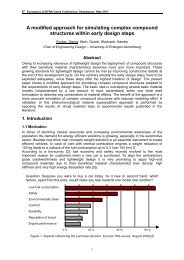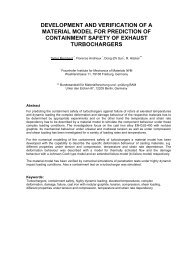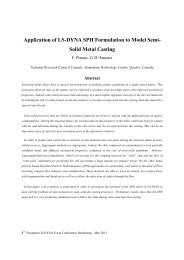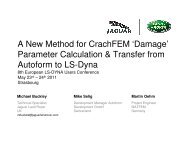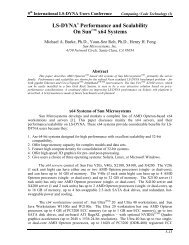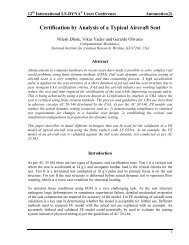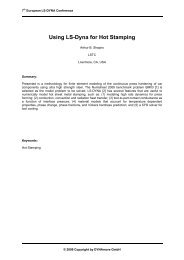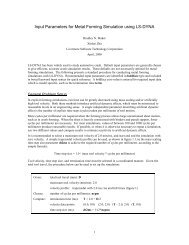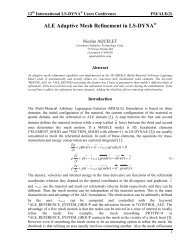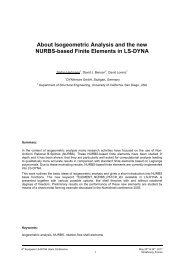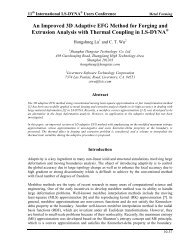Development of a thorax finite element model for ... - DYNAlook
Development of a thorax finite element model for ... - DYNAlook
Development of a thorax finite element model for ... - DYNAlook
You also want an ePaper? Increase the reach of your titles
YUMPU automatically turns print PDFs into web optimized ePapers that Google loves.
Abstract<br />
<strong>Development</strong> <strong>of</strong> a <strong>thorax</strong> <strong>finite</strong> <strong>element</strong> <strong>model</strong> <strong>for</strong> thoracic injury<br />
assessment<br />
Nestor N. Nsiampa, ir; C. Robbe, ir; A. Papy, ir Dr<br />
Department <strong>of</strong> Weapon Systems & Ballistics, Royal Military Academy,<br />
30, Renaissance Avenue - B-1000 Brussels - Belgium<br />
Kinetic energy non-lethal weapons (KE-NLW) are now widely used by law en<strong>for</strong>cement, by<br />
military <strong>for</strong>ces, by the police in situations where the use <strong>of</strong> lethal arms is not required or<br />
suitable. Un<strong>for</strong>tunately, their effects are still not well known. There<strong>for</strong>e, there is a need to<br />
better understand the injury mechanism induced by such projectiles <strong>for</strong> a better prediction <strong>of</strong><br />
the risk <strong>of</strong> injury. This may be beneficial <strong>for</strong> the manufacturer, the deciders or the end-users.<br />
Numerical simulations are being increasingly used <strong>for</strong> that purpose. This paper describes first<br />
steps in the development <strong>of</strong> <strong>finite</strong> <strong>element</strong> <strong>model</strong> <strong>for</strong> thoracic impacts. All the simulations<br />
were per<strong>for</strong>med with Ls-Dyna code. For validation purpose, the results were compared to the<br />
results <strong>of</strong> tests made on Post-Mortem Human Subjects (PMHS) published in literature. The<br />
sensitivity <strong>of</strong> contact option and the use <strong>of</strong> two sets <strong>of</strong> parameters <strong>for</strong> the lung material <strong>model</strong><br />
were examined.<br />
Keywords: non-lethal weapons, risk <strong>of</strong> injury, CT-scan, PMHS<br />
Introduction<br />
These last decades have seen the development <strong>of</strong> a new type <strong>of</strong> weapons, the nonlethal<br />
weapons. ‘Non-lethal weapons are weapons which are explicitly designed and developed to<br />
incapacitate or repel personnel, with a low probability <strong>of</strong> fatality or permanent injury, or to<br />
disable equipment, with minimal undesired damage or impact on the environment’ [1,2].<br />
They are now widely used by law en<strong>for</strong>cement or by the military <strong>for</strong>ces in situations where<br />
the use <strong>of</strong> conventional weapons is not required or suitable <strong>for</strong> example in peace-keeping<br />
missions or <strong>for</strong> crowd control. Unlike conventional weapons that may result in severe or fatal<br />
injuries, non-lethal weapons are designed <strong>for</strong> temporary incapacitation with reversible<br />
consequences or minor damage. There are generally short range weapons and are generally<br />
used to gain compliance <strong>of</strong> a human subject or a group <strong>of</strong> people. Dependant <strong>of</strong> the level <strong>of</strong><br />
threats, the spectrum range <strong>of</strong> non-lethal weapons covers from verbalization techniques to the<br />
use <strong>of</strong> a ‘reasonable <strong>for</strong>ce’, <strong>for</strong>ce which is necessary to achieve a legal goal. To the<br />
‘reasonable <strong>for</strong>ce’ is opposed the ‘excessive <strong>for</strong>ce’ which is a <strong>for</strong>ce disproportionate to what<br />
is necessary to achieve a legal goal [3].<br />
Although there is a variety <strong>of</strong> technologies (electric, chemical, acoustic, … [4]) used <strong>for</strong> the<br />
development <strong>of</strong> non-lethal weapons, this study is limited to kinetic energy non-lethal weapons<br />
(KENLW). Such weapons use the kinetic energy <strong>of</strong> a projectile to inflict physical injury, a<br />
result <strong>of</strong> the interaction <strong>of</strong> the projectile and the human body. The resulted injury is dependent<br />
<strong>of</strong> the nature <strong>of</strong> the projectile, the location and nature <strong>of</strong> the impacted zone and the impact<br />
conditions. The projectiles may be rigid, de<strong>for</strong>mable or can break at the impact. The most<br />
known KENLW projectiles are: baton rounds, beanbags, fin-stabilised rubber projectiles,<br />
multi-ball rounds, rubber ball rounds, and sponge grenades. In Figure 1, different types <strong>of</strong><br />
most known KENLW weapons and KENLW projectiles are presented. For example, the Flash<br />
8th European LS-DYNA Users Conference, Strasbourg - May 2011
all launcher and the COUGAR launcher use a pyrotechnic system to impart energy to the<br />
projectile. The flash ball projectile similar to the squash ball is a de<strong>for</strong>mable projectile as well<br />
as the bliniz projectile (COUGAR). The FN 303 weapon uses a compressed air system and a<br />
thin stabilized projectile which breaks generally at impact.<br />
KENLW projectiles are low-mass (8g - 140 g) and the high-velocity (15 m/s – 250 m/s)<br />
projectiles as opposed to the automotive crash tests field where mass are higher and velocities<br />
lower (Fig. 2).<br />
Figure 1: Example <strong>of</strong> KENLW weapons and different projectile types<br />
To avoid the risk <strong>of</strong> penetration wounding at impact, KENLW projectiles are designed in such<br />
a way that the primary and desired effect is blunt trauma.<br />
Figure 2: Differences in mass and velocity <strong>for</strong> automotive collisions and ‘non-lethal’ ballistic<br />
impacts on a logarithmic scale [2]<br />
These differences between the KENLW ballistic impacts and the crash tests impacts are<br />
reflected in the biomechanical responses <strong>of</strong> the human body [5] although some injury<br />
mechanisms are similar. In this paper thoracic impacts will be considered. The reasons are<br />
threefold:<br />
Besides the human head which is not considered as a target in KENLW field because<br />
<strong>of</strong> the low tolerance level <strong>of</strong> the eyes, the <strong>thorax</strong> encompasses vital organs <strong>of</strong> the body and<br />
represents a wide surface <strong>of</strong> the body where the hit probability is great;<br />
It has been reported [5] that thoracic injuries represented 50% <strong>of</strong> casualties among the<br />
fatal casualties related to some type <strong>of</strong> chest trauma;<br />
There are experimental data on Post Mortem Human Subjects (PMHS) available in the<br />
open literature <strong>for</strong> thoracic impacts [5]. Those data were used <strong>for</strong> validation purpose <strong>of</strong> the<br />
<strong>thorax</strong> <strong>finite</strong> <strong>element</strong> <strong>model</strong> (FEM) that has been developed. Force-time and deflection-time<br />
8th European LS-DYNA Users Conference, Strasbourg - May 2011
histories were compared to the experimental data. We will emphasize on problems<br />
encountered with the lung material <strong>model</strong> and the contact definition.<br />
Thorax FEM Model<br />
Thorax geometric <strong>model</strong><br />
There is an increasing interest in using numerical simulations as an important tool <strong>for</strong> the<br />
assessment and a better understanding <strong>of</strong> impact events. But reliable simulations depend on<br />
the accurate description <strong>of</strong> the geometry <strong>of</strong> the problem and on the use <strong>of</strong> appropriate material<br />
<strong>model</strong>s. The description <strong>of</strong> human <strong>thorax</strong> geometry can be found in most <strong>of</strong> books related to<br />
human anatomy. The human <strong>thorax</strong> is a complex structure because <strong>of</strong> the highly non-linear<br />
material properties and the shapes <strong>of</strong> different <strong>thorax</strong> organs (Fig. 3). It consists mainly <strong>of</strong> an<br />
external protective structure and an internal structure. The external protective structure<br />
consists <strong>of</strong> bony sub-structure (sternum, vertebral column, 12 pairs <strong>of</strong> ribs) and s<strong>of</strong>t-tissue<br />
sub-structure (intercostals muscles and flesh, skin). The internal structure consists <strong>of</strong> s<strong>of</strong>t<br />
tissues organs (heart, lungs, the trachea …). The combination or the interaction <strong>of</strong> s<strong>of</strong>t tissues<br />
and bones in the structure <strong>of</strong> the body as well as the various geometries <strong>of</strong> the <strong>thorax</strong> organs<br />
shows the difficulty in <strong>model</strong>ing the biomechanical response <strong>of</strong> the <strong>thorax</strong> to impact events.<br />
There<strong>for</strong>e some assumptions about the geometry and the material <strong>model</strong>s are made <strong>for</strong> the<br />
development <strong>of</strong> the <strong>model</strong> (Fig. 4).<br />
Figure 3. The cross-section <strong>of</strong> the <strong>thorax</strong> [6,7]<br />
Figure 4. The human <strong>thorax</strong> <strong>model</strong><br />
8th European LS-DYNA Users Conference, Strasbourg - May 2011
Thorax material <strong>model</strong><br />
The <strong>thorax</strong> main organs are <strong>model</strong>ed. All organs materials are considered as homogenous<br />
which there are not in reality. Material <strong>model</strong> parameters are given in Table 1-2.<br />
Material LS-DYNA cards (Units = m, kg, s)<br />
COSTAL CARTILAGE<br />
RIBS<br />
STERNUM<br />
HEART<br />
INTERCOSTALS<br />
FLESH/MUSCLE<br />
* MAT_ELASTIC<br />
RO E PR<br />
1281 4.9E+6 0.400<br />
RO E PR<br />
1561 7.9E+9 0.379<br />
RO E PR<br />
1354 3.5E+9 0.387<br />
*MAT_SIMPLIFIED_RUBBER/FOAM<br />
8th European LS-DYNA Users Conference, Strasbourg - May 2011<br />
RO K C LC/TBID<br />
1050 2.2 E+9 0.5035 1<br />
Table 1 –Material parameters [8,9]<br />
Two sets lung material parameters found in literature were used (Table 2).<br />
Material LS-DYNA cards (Units = m, kg, s)<br />
LUNG_01 * MAT_LUNG_TISSUE<br />
RO K C DELTA ALPHA BETA<br />
200 1E+5 0.5035 2.5 E-4 0.183 -0.291<br />
C1 C2 NT<br />
0.004825 2.71 6<br />
LUNG_02 * MAT_LUNG_TISSUE<br />
RO K C DELTA ALPHA BETA<br />
118 1.18E+5 0.5035 7.02E-5 0.08227 -2.46<br />
C1 C2 NT<br />
0.006535 2.876 6<br />
Table 2 – Lung material parameters [10,11]<br />
All the organs are <strong>model</strong>ed with solid hexa-<strong>element</strong>s except <strong>for</strong> the heart, the lungs and the<br />
trachea.
Projectile FEM Model<br />
PMHS experiments [5,6] were per<strong>for</strong>med with a PVC projectile corresponding to a plastic<br />
baton round used in real crowd control situations. Its characteristics are given in Fig. 5 and<br />
Table 3. Two velocities were used: 20 m/s and 40 m/s.<br />
PVC<br />
Interface conditions<br />
Figure 5. Projectile geometry<br />
* MAT_ELASTIC<br />
RO E PR<br />
1380 2.3E+6 0.33<br />
Table 3 – Projectile material parameters [5,8]<br />
Because <strong>of</strong> the number <strong>of</strong> <strong>thorax</strong> organs interacting together during the impact, contact<br />
definitions between organs are pertinent <strong>for</strong> the simulations. Interface contacts have been<br />
defined between different organs. TIED_NODES_TO_SURFACE or<br />
TIED_SURFACE_TO_SURFACE were defined between the different organs <strong>of</strong> the same<br />
structure (external or internal). AUTOMATIC_SURFACE_TO_SURFACE was defined<br />
between the internal and the external structures. All the vertebral column nodes were<br />
constrained.<br />
AUTOMATIC_SURFACE_TO_SURFACE contact was defined between the projectile and<br />
the external structure. Two cases were studied when we vary the contact parameter SOFT.<br />
The full <strong>model</strong> contains 350408 solid <strong>element</strong>s and 165667 nodes. Most <strong>of</strong> <strong>element</strong>s are hexa<strong>element</strong>s.<br />
Results et Discussion<br />
Validation <strong>of</strong> the <strong>thorax</strong> FEM <strong>model</strong> has been made against PMHS data <strong>for</strong> thoracic impacts<br />
[5]. Typical physical characteristics which are measured during impact testings <strong>for</strong> injury<br />
assessment are <strong>for</strong>ce-time histories and displacement (deflection)-time histories from which<br />
other characteristics or parameters are derived. Numerical results are then compared to<br />
experimental results <strong>for</strong> validation purpose. In our case, numerical results have to be within<br />
the biomechanical corridors which correspond to the upper and lower limits <strong>of</strong> the<br />
biomechanical responses [5]. Details <strong>of</strong> validation process can be found in [9,13].<br />
Lungs are one <strong>of</strong> the vital organs <strong>of</strong> the human body, there<strong>for</strong>e there is a necessity to predict<br />
lung injury in thoracic impacts as consequently to the impact against the <strong>thorax</strong>, the lung may<br />
be affected. There<strong>for</strong>e, one has to use a <strong>model</strong> which correctly simulates the lung behaviour<br />
under any solicitation. Because <strong>of</strong> the difficulty encountered during our simulation on the<br />
lung material, we tested two lung <strong>model</strong>s found in literature as tests on human lungs are not<br />
8th European LS-DYNA Users Conference, Strasbourg - May 2011
possible in our case. Two lung <strong>model</strong>s were then compared especially a comparison between<br />
two sets <strong>of</strong> parameters <strong>of</strong> a lung <strong>model</strong> (Table 2) is done in order to better understand the<br />
biomechanical response <strong>of</strong> the lung. This may give some indication <strong>of</strong> which lung <strong>model</strong> to<br />
use. Results show that <strong>for</strong> the velocity <strong>of</strong> 20 m/s, there is a good agreement regarding <strong>for</strong>cetime<br />
history and deflection-time history (Fig. 7-8).<br />
Figure 6. Dynamic <strong>for</strong>ce: comparison <strong>of</strong> the two <strong>model</strong>s<br />
Figure 7. Dynamic <strong>thorax</strong> deflection: comparison <strong>of</strong> the two <strong>model</strong>s<br />
But at 40 m/s, results are quite similar between the two <strong>model</strong>s but the calculation stops at<br />
1.26 ms <strong>for</strong> the ‘LUNG_01’ (Fig. 8) with an error message ‘complex sound speed in solid<br />
<strong>element</strong> in the lung’. Some <strong>element</strong>s were highly distorted (Fig. 9). We are still investigating<br />
why this <strong>model</strong> fails.<br />
8th European LS-DYNA Users Conference, Strasbourg - May 2011
Figure 8. Dynamic <strong>thorax</strong> deflection: comparison <strong>of</strong> the two <strong>model</strong>s<br />
Figure 9. Highly distorted mesh <strong>of</strong> the lungs when the calculation stops<br />
Another problem that we encountered is a contact problem. Many contact options are<br />
available <strong>for</strong> the different types <strong>of</strong> contact algorithms. Choose the best one is a challenge and<br />
require more experience in contact treatment. To better understand the contact option SOFT,<br />
AUTOMATIC_SURFACE_TO_SURFACE contact was defined between the projectile and<br />
the external structure and the SOFT option was used. Two cases were considered: SOFT=1<br />
and SOFT=2. The option SOFT=0 was not considered as it is almost similar to SOFT=1 [14].<br />
The results show <strong>for</strong> the two velocities that the option SOFT=1 is not appropriate <strong>for</strong> our<br />
problem as the calculation was aborted because <strong>of</strong> the complex sound speed in some solid<br />
<strong>element</strong>s in the lung. This problem <strong>of</strong> complex sound speed does not occur with the option<br />
SOFT=2.<br />
Conclusions<br />
8th European LS-DYNA Users Conference, Strasbourg - May 2011
Numerical simulations are an important tool in the understanding and the prediction <strong>of</strong> the<br />
biomechanical response <strong>of</strong> the human <strong>thorax</strong> against the impact <strong>of</strong> KENLW. But there are<br />
many challenges as reliable results depend not on accurate material <strong>model</strong>ing, the geometric<br />
<strong>model</strong>ing and the contact between different <strong>thorax</strong> organs. We have shown that through the<br />
problem <strong>of</strong> the lung material the difficulty in the material <strong>model</strong>ing <strong>of</strong> the human body. Each<br />
person is unique, there<strong>for</strong>e there exist a great variability in the properties <strong>of</strong> a human<br />
depending <strong>of</strong> many factors (gender, age,…).<br />
The way all organs interact is important <strong>for</strong> the definition <strong>of</strong> the contact type. We have shown<br />
that depending <strong>of</strong> the type <strong>of</strong> the problem, the choice <strong>of</strong> which parameter or which option to<br />
use is not simple.<br />
References<br />
[1] NATO mission statement, October 13, 1999<br />
[2] B. Koene, F. Id-Boufker, A. Papy, Kinetic Non-Lethal Weapons, Netherlands Annual<br />
Review <strong>of</strong> Military Studies, 2008<br />
[3] C. Mesloh, M. Henych, R. Wolf, Less Lethal Weapon Effectiveness, Use <strong>of</strong> Force, and<br />
Suspect & Office Injuries: A Five-Year Analysis, 2005-IJ-CX-K050, September 2008<br />
[4] N. Lewer, N. Davison, Non-lethal technologies—an overview, Science, Technology and<br />
the CBW Regimes, 2005<br />
[5] C.A. Bir, The evaluation <strong>of</strong> blunt ballistic impacts <strong>of</strong> <strong>thorax</strong>, Ph. D. Thesis, Wayne State<br />
University, Detroit,2000.<br />
[6] http://www.etcvsg.com/surgicalprocedures.html/<br />
[7] http://www.valeedge.com/edgicine/cutting_edge_apr04.html<br />
[8] A.Bouamal, H.Lévesque, <strong>Development</strong> and validation <strong>of</strong> a <strong>finite</strong> <strong>element</strong> human <strong>thorax</strong><br />
<strong>model</strong> under blunt ballistic trauma –Valcartier, Canada, 2007.<br />
[9] N. N. Nsiampa, C. Robbe, A. Papy, Numerical simulation <strong>of</strong> non-lethal projectiles on<br />
human <strong>thorax</strong>, ISB 2011 (to be published)<br />
[10] Stitzel J. D., Gayzik F.S., Hoth J.J., Mercier J., Gage D.H., Morton K.A, Duma S.M,<br />
Payne R.M.,2005, <strong>Development</strong> <strong>of</strong> a Finite Element-Based Injury Metric <strong>for</strong> Pulmonary<br />
Contusion Part I: Model <strong>Development</strong> and Validation, Stapp Car Crash Journal, Vol. 49, The<br />
Stapp Association, pp.271-289.<br />
[11] [5] D.L. Vawter, A <strong>finite</strong> <strong>element</strong> <strong>model</strong> <strong>for</strong> macroscopic de<strong>for</strong>mation <strong>of</strong> the lung, Journal<br />
<strong>of</strong> Biomedical Engineering, February 1980, Vol. 102/1.<br />
[12] K.U. Schmitt, P. Niederer, M. Muser, F. Walz, Trauma Biomechanics – Accidental<br />
injury in traffic and sports, 3rd Ed. – Springer – p. 161.<br />
8th European LS-DYNA Users Conference, Strasbourg - May 2011
[13] N. N. Nsiampa, C. Robbe, A. Papy, Numerical investigation <strong>of</strong> impact <strong>of</strong> non lethal<br />
kinetic projectiles onto human <strong>thorax</strong>, 6th European Symposium on Non-Lethal Weapons,<br />
2011 (to be published)<br />
[14] http://www.dynasupport.com/howtos/contact/s<strong>of</strong>t-option<br />
8th European LS-DYNA Users Conference, Strasbourg - May 2011



